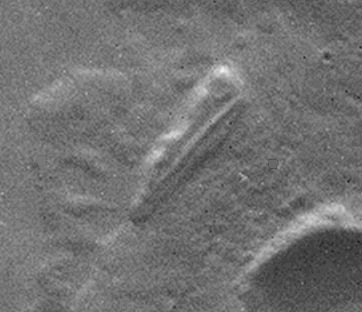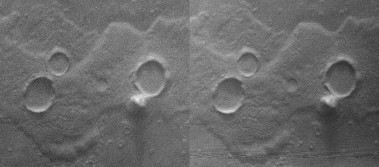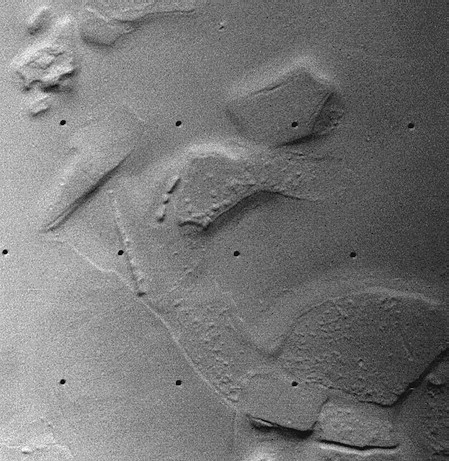THE "FORGOTTEN" ANOMALIES
OF MARS
Researcher Advocates Taking
a Closer Look
(excerpted from CNI News)
By Daniel Drasin
Click Here to play "The Ultimate Life",
by Michael Walthius:
Ultimate
or Ultimate 32
Recent
high-resolution images from NASA's Mars Global Surveyor spacecraft have
failed to confirm the theorized artificiality of the Face on Mars, or that
of its neighboring "City," beyond a
reasonable doubt.
However,
with so much attention focused on the Face and City, it has been easy to
forget that there remain several Martian features that appear to be at
least as anomalous and far less dependent upon subjective interpretation.
They are known to researchers as The
"Cliff," the "Crater Pyramid" and the "String of
Beads" (formerly called the "Runway"). As the principal photographic
consultant to the independent Mars investigations
since 1984, I have long been fascinated
by these peculiar landforms and sincerely hope that they will be
targeted for high-resolution imaging during
the forthcoming Mars Global Surveyor
mapping mission.
2x enlargement from Viking frame 35A73
40.35 N, 8.96 W
Two registration marks were removed.
 THE
CLIFF, located northeast of the Face, is a 2 km-long mesa that rises about
30 meters above a pancake-like "crater pedestal."
The Cliff's outlines, surface texture
and internal structure differ markedly from that of the surrounding
crater ejecta material, indicating that its formation post-dated
that of the crater itself. Geologists point
out that had the Cliff pre-dated the
impact, the debris ejected by the cratering force would have been dammed
up on its eastern side, burying, distorting
or destroying the Cliff entirely. The
exact opposite, however, seems to have occurred: the terrain on the
Cliff's eastern side, rather than being heaped
up, appears instead to have been hollowed
out, with this hollow area displaying an unnaturally crisp outline.
From this depression a smooth, unbroken path climbs in a northwesterly
direction to the top of the Cliff, where it makes a hair-pin turn
southward along the Cliff's ruler-straight ridge. After wrapping cleanly
around the ridgeline, it heads northward to
terminate at the Cliff's northwestern
extremity.
THE
CLIFF, located northeast of the Face, is a 2 km-long mesa that rises about
30 meters above a pancake-like "crater pedestal."
The Cliff's outlines, surface texture
and internal structure differ markedly from that of the surrounding
crater ejecta material, indicating that its formation post-dated
that of the crater itself. Geologists point
out that had the Cliff pre-dated the
impact, the debris ejected by the cratering force would have been dammed
up on its eastern side, burying, distorting
or destroying the Cliff entirely. The
exact opposite, however, seems to have occurred: the terrain on the
Cliff's eastern side, rather than being heaped
up, appears instead to have been hollowed
out, with this hollow area displaying an unnaturally crisp outline.
From this depression a smooth, unbroken path climbs in a northwesterly
direction to the top of the Cliff, where it makes a hair-pin turn
southward along the Cliff's ruler-straight ridge. After wrapping cleanly
around the ridgeline, it heads northward to
terminate at the Cliff's northwestern
extremity.
Another
striking aspect of the Cliff's surroundings is the uniquely striated
or "plowed-field" texture of the terrain between
the Cliff and its crater. Researchers
have speculated that this may constitute evidence of the quarrying
of material for the Cliff's construction.
Finally,
the crater itself appears to incorporate a small pyramidal structure
in its rim. It has been argued that this feature
marks a key point in the theorized
relational geometries of the Cydonia "complex."
Portion of Viking frames 43A01 and 43A03
46.4N, 3.2 W
(Click on image for full resolution stereo
view)
 THE
CRATER PYRAMID, Deuteronilius Mensae, is located about 800 km northeast
of Cydonia. Viking imaged this apparently
four-sided pyramidal formation situated on
the ejecta blanket of a large impact crater. Whereas the Cliff at Cydonia
is separate and distinct from its associated
crater, the Crater Pyramid actually
intersects its crater's rim; yet, like the Cliff, it lacks the expected
impact damage or surrounding debris flows. Over a kilometer square at
its base and at least 600 meters high, the
Crater Pyramid is the tallest object
within a 100 km radius.
THE
CRATER PYRAMID, Deuteronilius Mensae, is located about 800 km northeast
of Cydonia. Viking imaged this apparently
four-sided pyramidal formation situated on
the ejecta blanket of a large impact crater. Whereas the Cliff at Cydonia
is separate and distinct from its associated
crater, the Crater Pyramid actually
intersects its crater's rim; yet, like the Cliff, it lacks the expected
impact damage or surrounding debris flows. Over a kilometer square at
its base and at least 600 meters high, the
Crater Pyramid is the tallest object
within a 100 km radius.
Below
the Crater Pyramid's crater is a similar crater of nearly equal size
whose surrounding ejecta blanket displays
a unique arrangement of furrows. Unlike
natural erosional channels, these do not seem to branch out radially
but originate in a straight line running tangent
to the crater's bowl. No conventional
explanation has been advanced to account for these furrows.
Portion of Viking frame 86A08
34.7 N, 212.8 W
(Click on image for 2x enlargement)
 THE
STRING OF BEADS, halfway around the planet from Cydonia, in Mars' Utopia
Planitia region, is one of the most puzzling
features observed to date on Mars.
Discovered by researchers John Brandenburg and Vincent DiPietro in the
early 1980s, it was originally dubbed the
"Runway" due to its appearance as a tiny,
straight line in Viking frame 86A08. When magnified, it turned out to be
THE
STRING OF BEADS, halfway around the planet from Cydonia, in Mars' Utopia
Planitia region, is one of the most puzzling
features observed to date on Mars.
Discovered by researchers John Brandenburg and Vincent DiPietro in the
early 1980s, it was originally dubbed the
"Runway" due to its appearance as a tiny,
straight line in Viking frame 86A08. When magnified, it turned out to be
a
four-kilometer-long string of mounds or pyramids apparently linked by an
off-center shaft. The structure seems to be
emerging from beneath gently sloping
terrain and appears to be surrounded by vestiges of a shallow basin.
Close
by, there is another, more clearly defined basin surrounding a "bow-
tie"-shaped arrangement of three unnaturally
smooth structures about two kilometers
in overall length. At the edge of the adjoining mesa, a curious
oval formation encloses an apparent gridlike,
cellular structure.
According
to its discoverers, the String of Beads was located by tracing the
course of an ancient water channel to its
source. The concept underlying this search
was to find a location on Mars which, like the Cydonia area, included
mesas bordering what once may have been a
large bay or lake.
The
"Cliff," the "Crater Pyramid" and the "String of Beads" share at least
four key characteristics with virtually all
of the Martian anomalies:
1)
To the eye they appear distinctly out of character, virtually popping out
of the landscape in NASA's 1976 Viking images.
2)
They seem to defy conventional geomorphological explanation.
3)
They all fall within a limited size range -- about 1-4 km in their longest
dimensions. Such a constraint is uncharacteristic
of natural landforms.
4)
Each is the dominant feature in a grouping of associated anomalies.
Note from Anomalous Images: If you
would like to see there areas in more detail, please send an email to Dr.
Michael Malin, president of Malin Space Science Systems and Chief Investigator
for Mars Global Surveyor. During the pause between aerobraking maneuvers,
there will be excellent opportunities to obtain extremely high resolution
images of these and other anomalous areas on Mars.
Click here to send an email to Dr
Malin:
Dr.
Michael Malin, Malin Space Science Systems <malin@msss.com>
Your help is appreciated and will make
a difference!
All images on this page Copyright 1998 by Anomalous
Images and Steve Wingate, all rights reserved.
 Return
to Main Page
Return
to Main Page
 THE
CLIFF, located northeast of the Face, is a 2 km-long mesa that rises about
30 meters above a pancake-like "crater pedestal."
The Cliff's outlines, surface texture
and internal structure differ markedly from that of the surrounding
crater ejecta material, indicating that its formation post-dated
that of the crater itself. Geologists point
out that had the Cliff pre-dated the
impact, the debris ejected by the cratering force would have been dammed
up on its eastern side, burying, distorting
or destroying the Cliff entirely. The
exact opposite, however, seems to have occurred: the terrain on the
Cliff's eastern side, rather than being heaped
up, appears instead to have been hollowed
out, with this hollow area displaying an unnaturally crisp outline.
From this depression a smooth, unbroken path climbs in a northwesterly
direction to the top of the Cliff, where it makes a hair-pin turn
southward along the Cliff's ruler-straight ridge. After wrapping cleanly
around the ridgeline, it heads northward to
terminate at the Cliff's northwestern
extremity.
THE
CLIFF, located northeast of the Face, is a 2 km-long mesa that rises about
30 meters above a pancake-like "crater pedestal."
The Cliff's outlines, surface texture
and internal structure differ markedly from that of the surrounding
crater ejecta material, indicating that its formation post-dated
that of the crater itself. Geologists point
out that had the Cliff pre-dated the
impact, the debris ejected by the cratering force would have been dammed
up on its eastern side, burying, distorting
or destroying the Cliff entirely. The
exact opposite, however, seems to have occurred: the terrain on the
Cliff's eastern side, rather than being heaped
up, appears instead to have been hollowed
out, with this hollow area displaying an unnaturally crisp outline.
From this depression a smooth, unbroken path climbs in a northwesterly
direction to the top of the Cliff, where it makes a hair-pin turn
southward along the Cliff's ruler-straight ridge. After wrapping cleanly
around the ridgeline, it heads northward to
terminate at the Cliff's northwestern
extremity.

